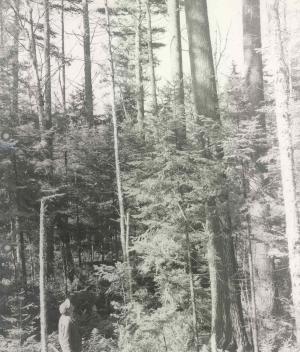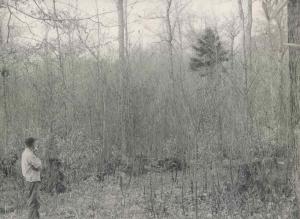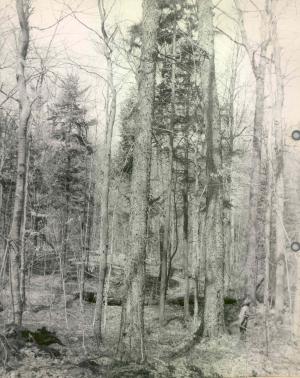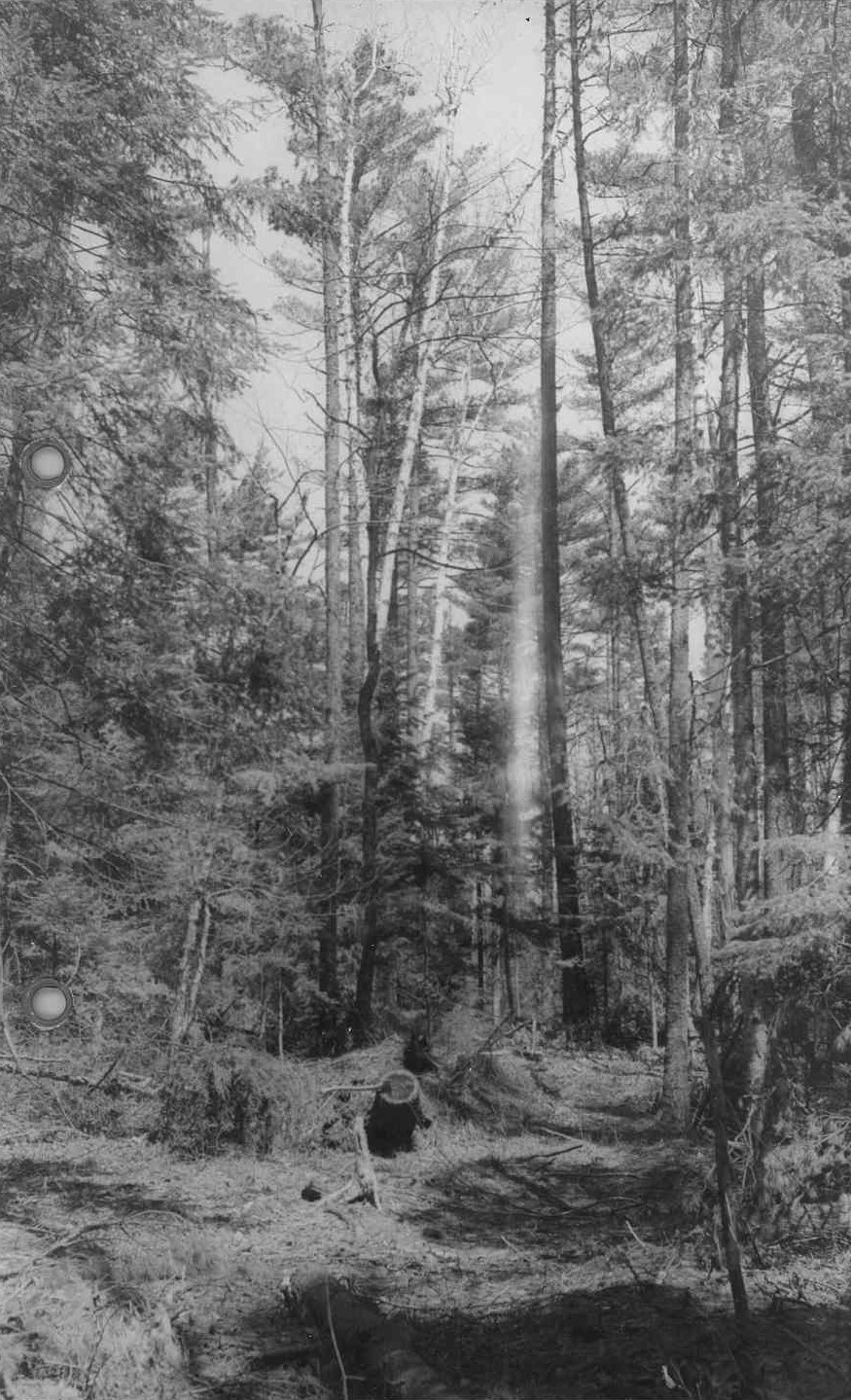| Collection: | Paul Smith Experimental Forest Historical Photo Archive |
| Keywords: |
post-harvest personnel |
| Organisms: | yellow birch |
| Location: | Paul Smith Experimental Forest; Compartment 53 |
| Description: | Residual stand photo of location in photo 418 (PSEF_MU53_165). Taken facing N87E 1.42 chains N54E of stake 79-23. Northern hardwood forest with pole size yellow birch, only major change is poisoned cull hardwood. |
| Date: | 11/13/1958 |
| Collection: | Paul Smith Experimental Forest Historical Photo Archive |
| Keywords: | personnel |
| Location: | Paul Smith Experimental Forest; Compartment 29 |
| Description: | In October 1956. |
| Date: | 1956 |
| Collection: | Paul Smith Experimental Forest Historical Photo Archive |
| Keywords: | personnel |
| Organisms: | balsam fir |
| Location: | Paul Smith Experimental Forest; Compartment 29 |
| Description: | In October 1956. |
| Date: | 1956 |
| Collection: | Paul Smith Experimental Forest Historical Photo Archive |
| Keywords: | softwood |
| Organisms: | hemlock |
| Location: | Paul Smith Experimental Forest; Compartment 29 |
| Description: | In October 1956. |
| Date: | 1956 |
| Collection: | Paul Smith Experimental Forest Historical Photo Archive |
| Keywords: |
personnel blowdown |
| Location: | Paul Smith Experimental Forest; Compartment 29 |
| Description: | In October 1956. |
| Date: | 1956 |
| Collection: | Paul Smith Experimental Forest Historical Photo Archive |
| Keywords: | softwood |
| Organisms: | spruce |
| Location: | Paul Smith Experimental Forest; Compartment 29 |
| Description: | In October 1956. |
| Date: | 1956 |
| Collection: | Paul Smith Experimental Forest Historical Photo Archive |
| Keywords: | personnel |
| Organisms: | maple |
| Location: | Paul Smith Experimental Forest; Compartment 29 |
| Description: | In October 1956. |
| Date: | 1956 |
| Collection: | Paul Smith Experimental Forest Historical Photo Archive |
| Keywords: |
personnel blowdown |
| Organisms: | balsam fir |
| Location: | Paul Smith Experimental Forest; Compartment 29 |
| Description: | In October 1956. |
| Date: | 1956 |
| Collection: | Paul Smith Experimental Forest Historical Photo Archive |
| Keywords: |
personnel pre-harvest |
| Organisms: |
yellow birch maple |
| Location: | Paul Smith Experimental Forest |
| Description: | Part of stand at lower elevation, before cutting occurred in 1955. |
| Date: | 1955 |
| Collection: | Paul Smith Experimental Forest Historical Photo Archive |
| Keywords: |
blowdown old growth |
| Organisms: | hemlock |
| Location: | Paul Smith Experimental Forest |
| Description: | Severe winds can cause damage even to these old veteran hemlocks. They exceed 200 years of age, and withstood storms until soil moisture, wind strength and direction, and their own large size led to their destruction. Prior to the storm, no cutting had occured here within 50 years. Some logs were salvaged. |
| Date: | 1950 |
| Collection: | Paul Smith Experimental Forest Historical Photo Archive |
| Keywords: |
personnel wildlife |
| Organisms: | brown trout |
| Location: | Paul Smith Experimental Forest |
| Description: | "Occassionally a brown trout like this one helps compensate for long winters, low wages, and 'conferences' with our wives to explain why we didn't stay at home and cut the lawn. This one was 23 inches long and weighed 5 lbs 8 oz (on the Post Office scale with only one sheet of newspaper to pad the weight)." |
| Date: | 1950 |
| Collection: | Paul Smith Experimental Forest Historical Photo Archive |
| Keywords: | blowdown |
| Organisms: | spruce |
| Location: | Paul Smith Experimental Forest |
| Description: | Windfall can be severe on heavily cut over spruce flats, in pockets where the soil remains wet. |
| Date: | 1950 |
| Collection: | Paul Smith Experimental Forest Historical Photo Archive |
| Keywords: |
reproduction personnel |
| Organisms: | hemlock |
| Location: | Paul Smith Experimental Forest |
| Description: | Dense hemlock stands do not encourage the development of either softwood or hardwood reproduction. |
| Date: | 1950 |
| Collection: | Paul Smith Experimental Forest Historical Photo Archive |
| Keywords: |
old growth softwood personnel |
| Organisms: |
white pine red spruce balsam fir |
| Location: | Paul Smith Experimental Forest |
| Description: | Overstory of 100-year-old white pine with dense understory of tolerant balsam fir and red spruce. This is typical in this vicinity. There is little opportunity for new white pines. These 100-year-old pines originated after an extremely hot fire burned heavy softwood slash. |
| Date: | 1950 |
| Collection: | Paul Smith Experimental Forest Historical Photo Archive |
| Keywords: |
personnel second growth post harvest |
| Organisms: |
white pine red spruce balsam fir |
| Location: | Paul Smith Experimental Forest |
| Description: | After large white pines were cut about 40 years ago, these understory red spruce and balsam fir - and a few pines - occupied the site. |
| Date: | 1950 |
| Collection: | Paul Smith Experimental Forest Historical Photo Archive |
| Keywords: |
softwood regeneration gap |
| Organisms: | white pine |
| Location: | Paul Smith Experimental Forest |
| Description: | An old field in the Farm Woodlot reverting to white pine and hardwoods. The first pines have been severely weeviled, but younger pines -- afforded some overstory protection -- have suffered little damage. White pine in the Paul Smiths area is regenerating only on old fields, and on some sandy soils. |
| Date: | 1950 |
| Collection: | Paul Smith Experimental Forest Historical Photo Archive |
| Keywords: |
personnel harvest log deck stump |
| Organisms: |
white pine balsam fir spruce |
| Location: | Paul Smith Experimental Forest |
| Description: | After a stand of large pines were cut about 1900, understory balsam fir and spruce developed to pulpwood size. Only a few pines originated after the cutting in 1900, because spruce and fir already occupied the site. |
| Date: | 1950 |
| Collection: | Paul Smith Experimental Forest Historical Photo Archive |
| Keywords: |
personnel blowdown |
| Organisms: | red spruce |
| Location: | Paul Smith Experimental Forest |
| Description: | Hardwood seedlings are encouraged in less-dense stands of red spruce. The 1950 hurricane helped open the stand. |
| Date: | 1950 |
| Collection: | Paul Smith Experimental Forest Historical Photo Archive |
| Keywords: | softwood |
| Organisms: |
balsam fir red spruce |
| Location: | Paul Smith Experimental Forest |
| Description: | Loss of occassional stems from this dense stand of softwoods was enough to encourage balsam fir and red spruce seedlings. Few hardwoods develop under these circumstances. Soil moisture is abundant and probably has a strong influence. |
| Date: | 1950 |
| Collection: | Paul Smith Experimental Forest Historical Photo Archive |
| Keywords: |
personnel hardwood old growth |
| Organisms: |
yellow birch beech |
| Location: | Paul Smith Experimental Forest |
| Description: | The continuing decadence of yellow birch over 200 years old create openings favorable for beech and other tolerant hardwoods. |
| Date: | 1950 |
| Collection: | Paul Smith Experimental Forest Historical Photo Archive |
| Keywords: |
log deck harvest personnel |
| Location: | Paul Smith Experimental Forest |
| Description: | Large cuts of softwoods in mixedwood stands, and light cutting for hardwoods, can convert some stands to hardwoods. "Is it desirable or undesirable? Will residual hardwoods make satisfactory growth? Will they be sound upon reaching merchantable size? Can the land owner afford to do anything different than this?" |
| Date: | 1950 |
| Collection: | Paul Smith Experimental Forest Historical Photo Archive |
| Keywords: |
personnel hardwood |
| Organisms: |
beech yellow birch maple |
| Location: | Paul Smith Experimental Forest |
| Description: | A situation that is common in the Adirondacks: mature yellow birch and hard maple, with beech in a secondary position. In similar stands, cutting of the better hardwoods -- with only a limited market for beech -- has put beech in a dominant position. With the abundance of beech reproduction of all sizes, lack of hard maple of similar sizes, and the intolerance of the birch, it appears that beech can remain in possession of such sites for a long time. "Is this desirable or undesirable?" |
| Date: | 1950 |
| Collection: | Paul Smith Experimental Forest Historical Photo Archive |
| Keywords: | hardwood |
| Organisms: |
red maple balsam fir |
| Location: | Paul Smith Experimental Forest |
| Description: | On the Farm Woodlot poor-quality red maples were poisoned to release balsam fir. The maple at the left is riddled with heart rot. These red maples occupied this site for 40 years and most of them now prove to be unmerchantable because of extensive heartrot. "Have 40 years been wasted? Can we anticipate this and prevent it? Is it worth it?" |
| Date: | 1950 |
| Collection: | Paul Smith Experimental Forest Historical Photo Archive |
| Keywords: |
gap personnel hardwood reproduction |
| Organisms: |
maple beech |
| Location: | Paul Smith Experimental Forest |
| Description: | Large openings encouraged hard maple and beech reproduction. The large trees did not meet current standards of merchantability and were not wanted by the cutters 6 years earlier. Improving markets may permit harvest of some trees in the furture, but others are cull. "Can and should anything be done to help the better saplings? Would there be long-range benefits to compensate for investments made to improve the stand?" |
| Date: | 1950 |
| Collection: | Paul Smith Experimental Forest Historical Photo Archive |
| Keywords: |
selection post-harvest hardwood |
| Organisms: |
maple yellow birch white ash |
| Location: | Paul Smith Experimental Forest |
| Description: | With light selection cutting (residual stand 70 sq. ft. B.A.) existing understory beech were benefited, but few hard maple, white ash, and yellow birch seedlings grew more than 12 inches high. This is 17 years after the first cutting. "Does this happen only on less-fertile soils? Would hard maples have reacted like this on more-fertile soils? Maple seed trees were more abundant here than beech seed trees." |
| Date: | 1950 |
| Collection: | Paul Smith Experimental Forest Historical Photo Archive |
| Keywords: |
personnel stump hardwood pulpwood |
| Organisms: | maple |
| Location: | Paul Smith Experimental Forest |
| Description: | A hardwood stand "creamed" for sawlogs 6 years earlier. The stand is too far from existing hardwood pulpwood markets. "Can anything be done to rehabilitate the stand? Should only the cull trees be poisoned, assuming it could be done for less than $6.00 per acre? What would you do with it?" |
| Date: | 1950 |
| Collection: | Paul Smith Experimental Forest Historical Photo Archive |
| Keywords: |
personnel stump post-harvest reproduction |
| Organisms: |
beech maple yellow birch |
| Location: | Paul Smith Experimental Forest |
| Description: | The same place after the first cut. Poor quality beech were poisoned 19 months earlier, and were debarked with frill and sodium arsenite for $4.13 per acre. It is anticipated that hard maple and yellow birch reproduction will have a better opportunity to become established without competition from the beech. |
| Date: | 1950 |
| Collection: | Paul Smith Experimental Forest Historical Photo Archive |
| Keywords: | post-harvest |
| Organisms: | maple |
| Location: | Paul Smith Experimental Forest |
| Description: | Same area after cutting. |
| Date: | 1950 |
| Collection: | Paul Smith Experimental Forest Historical Photo Archive |
| Keywords: | post-harvest |
| Organisms: | maple |
| Location: | Paul Smith Experimental Forest |
| Description: | Same area after cutting. |
| Date: | 1950 |
| Collection: | Paul Smith Experimental Forest Historical Photo Archive |
| Keywords: |
personnel reproduction |
| Organisms: |
beech maple |
| Location: | Paul Smith Experimental Forest |
| Description: | "On some spots beech were nearly all poisoned. We can compare the results with other compartments where varying numbers of beech were left. Hard maple advance reproduction is abundant here. It is about 14 inches high and 7 years old. Most of those about 3 feet high are beech. What will happen to them?" |
| Date: | 1950 |
| Collection: | Paul Smith Experimental Forest Historical Photo Archive |
| Keywords: |
pre-harvest old growth |
| Organisms: | yellow birch |
| Location: | Paul Smith Experimental Forest |
| Description: | Large yellow birch more than 200 years old, before the stand was cut. |
| Date: | 1950 |
| Collection: | Paul Smith Experimental Forest Historical Photo Archive |
| Keywords: |
personnel pre-harvest |
| Organisms: | maple |
| Location: | Paul Smith Experimental Forest |
| Description: | Before cutting. |
| Date: | 1950 |
| Collection: | Paul Smith Experimental Forest Historical Photo Archive |
| Keywords: | pre-harvest |
| Organisms: | maple |
| Location: | Paul Smith Experimental Forest |
| Description: | Before cutting. |
| Date: | 1950 |
| Collection: | Paul Smith Experimental Forest Historical Photo Archive |
| Keywords: |
personnel post-harvest |
| Organisms: |
red spruce white pine balsam fir |
| Location: | Paul Smith Experimental Forest |
| Description: | Understory red spruce, balsam fir, and a few white pines occupied the site after large overstory pines were cut about 40 years ago. |
| Date: | 1950 |
| Collection: | Paul Smith Experimental Forest Historical Photo Archive |
| Keywords: |
personnel blowdown |
| Organisms: | balsam fir |
| Location: | Paul Smith Experimental Forest |
| Description: | Balsam fir, about 70 years old, was partially uprooted by hurricane Hazel. |
| Date: | 1950 |
| Collection: | Paul Smith Experimental Forest Historical Photo Archive |
| Keywords: |
personnel blowdown gap |
| Organisms: | red maple |
| Location: | Paul Smith Experimental Forest |
| Description: | Opening made by severe windstorms in 1950 and 1954. Nearly all of the 60-80-year-old red maples are severely affected by heart rot at each overgrown limb; they have been poisoned to release the softwoods. If the young maples developing in the opening are not controlled, they will someday duplicate the present overstory condition. |
| Date: | 1950 |
| Collection: | Paul Smith Experimental Forest Historical Photo Archive |
| Keywords: |
gap blowdown |
| Organisms: |
red maple raspberry |
| Location: | Paul Smith Experimental Forest |
| Description: | Large opening made by 1950 windfall did not have understory softwoods, and it was occupied by red maple seedlings and red raspberry 6 years later. |
| Date: | 1950 |
| Collection: | Paul Smith Experimental Forest Historical Photo Archive |
| Keywords: | hardwood |
| Organisms: | maple |
| Location: | Paul Smith Experimental Forest |
| Description: | Poor-quality red maples 60-80 years old, and containing considerable heart rot, were poisoned to release softwoods. |
| Date: | 1950 |
| Collection: | Paul Smith Experimental Forest Historical Photo Archive |
| Keywords: | old growth |
| Organisms: |
white pine paper birch |
| Location: | Paul Smith Experimental Forest |
| Description: | Large white pines were lost here in the 1950 hurricane. The 100-year-old white birch are deteriorating. |
| Date: | 1950 |
| Collection: | Paul Smith Experimental Forest Historical Photo Archive |
| Keywords: |
slash gap |
| Organisms: | maple |
| Location: | Paul Smith Experimental Forest |
| Description: | 100 years ago, slash probably was not heavy here and the light fire did not destroy many trees. This is a drier site than (C19 - 170) and understory hardwoods develop in openings. |
| Date: | 1950 |
| Collection: | Paul Smith Experimental Forest Historical Photo Archive |
| Keywords: |
shelterwood post-harvest slash |
| Organisms: | white pine |
| Location: | Paul Smith Experimental Forest |
| Description: | This shelterwood can remain 10-15 years, but some of the best pines will be permitted to remain for quality production. |
| Date: | 1950 |
| Collection: | Paul Smith Experimental Forest Historical Photo Archive |
| Keywords: | pulpwood |
| Organisms: |
red maple paper birch |
| Location: | Paul Smith Experimental Forest |
| Description: | Red maple and white birch interfering with softwood were treated with frill and sodium arsenite. This will destroy them and also peel the bark to make them suitable for pulpwood. |
| Date: | 1950 |
| Collection: | Paul Smith Experimental Forest Historical Photo Archive |
| Keywords: |
personnel road equipment slash |
| Location: | Paul Smith Experimental Forest |
| Description: | A small TD 6 tractor easily made truck roads in this sandy soil. |
| Date: | 1950 |
| Collection: | Paul Smith Experimental Forest Historical Photo Archive |
| Keywords: |
post-harvest blowdown |
| Organisms: | white pine |
| Location: | Paul Smith Experimental Forest |
| Description: | After cutting in 1953, hurricane Hazel one year later caused only minor windfall damage among the residual white pine. |
| Date: | 1950 |
| Collection: | Paul Smith Experimental Forest Historical Photo Archive |
| Keywords: |
post-harvest stump gap blowdown road personnel |
| Location: | Paul Smith Experimental Forest |
| Description: | More than half the basal area was cut. Windfall before cutting and mature trees contributed to this excessive opening. |
| Date: | 1950 |
| Collection: | Paul Smith Experimental Forest Historical Photo Archive |
| Keywords: |
post-harvest old growth |
| Organisms: | paper birch |
| Location: | Paul Smith Experimental Forest |
| Description: | Some areas were only lightly disturbed by the first cut. The 100-year-old white birch contained too much heartwood to satisfy turning-wood markets within a reasonable distance. |
| Date: | 1950 |
| Collection: | Paul Smith Experimental Forest Historical Photo Archive |
| Keywords: |
shelterwood log deck slash |
| Location: | Paul Smith Experimental Forest |
| Description: | There was less exposure where windfall had not occured prior to cutting. This shelterwood can be cut in 10-15 years. |
| Date: | 1950 |
| Collection: | Paul Smith Experimental Forest Historical Photo Archive |
| Keywords: |
post-harvest gap regeneration |
| Organisms: |
beech witch hobble |
| Location: | Paul Smith Experimental Forest |
| Description: | On higher ground, beech and witch hobble occupied some large openings 3 years after cutting. |
| Date: | 1950 |
| Collection: | Paul Smith Experimental Forest Historical Photo Archive |
| Keywords: |
personnel old growth blowdown post-harvest |
| Organisms: |
hemlock yellow birch |
| Location: | Paul Smith Experimental Forest |
| Description: | Mature hemlock and yellow birch probably exceeding 200 years of age. An analysis of growth rings on nearby hemlock stumps indicates that severe windfall probably occured about 1790, and that cutting occurred about 1860 and 1905. |
| Date: | 1950 |
| Collection: | Paul Smith Experimental Forest Historical Photo Archive |
| Keywords: |
personnel old growth |
| Organisms: | hemlock |
| Location: | Paul Smith Experimental Forest |
| Description: | The large hemlocks could exceed 300 years of age. The oldest we have found so far was 341 years old. |
| Date: | 1950 |


















































